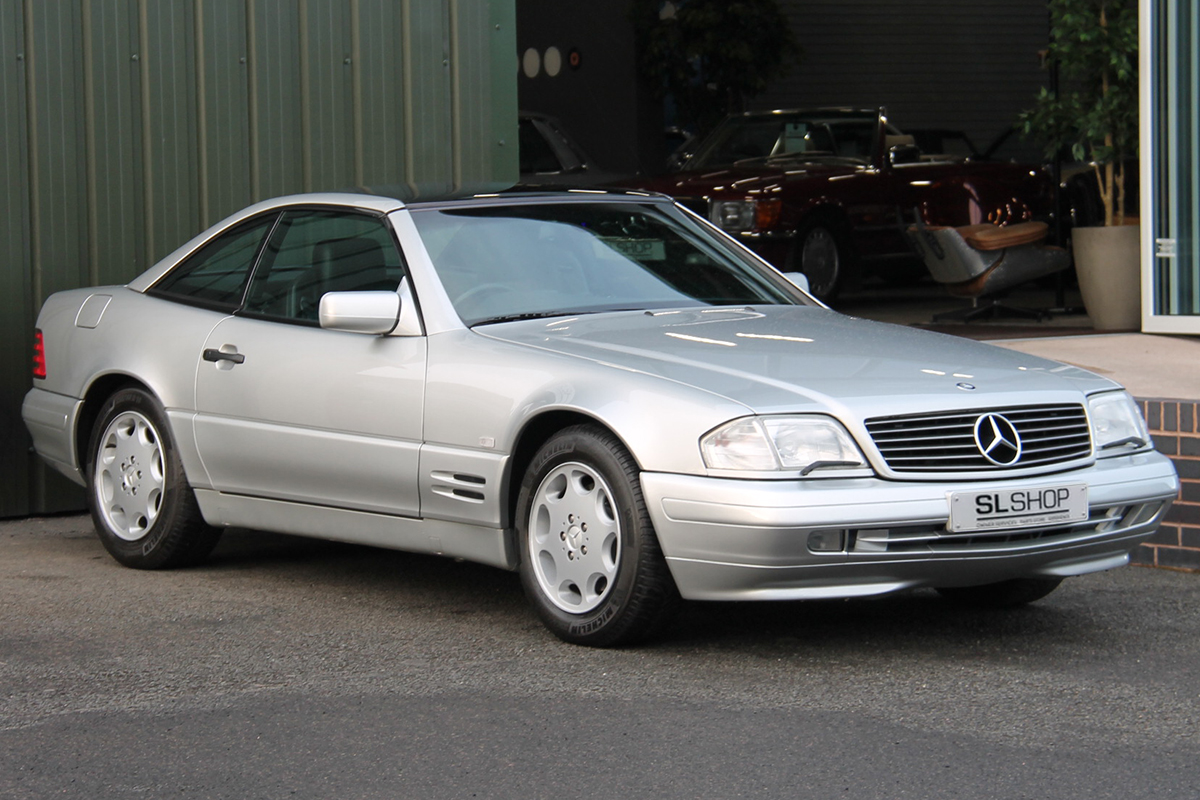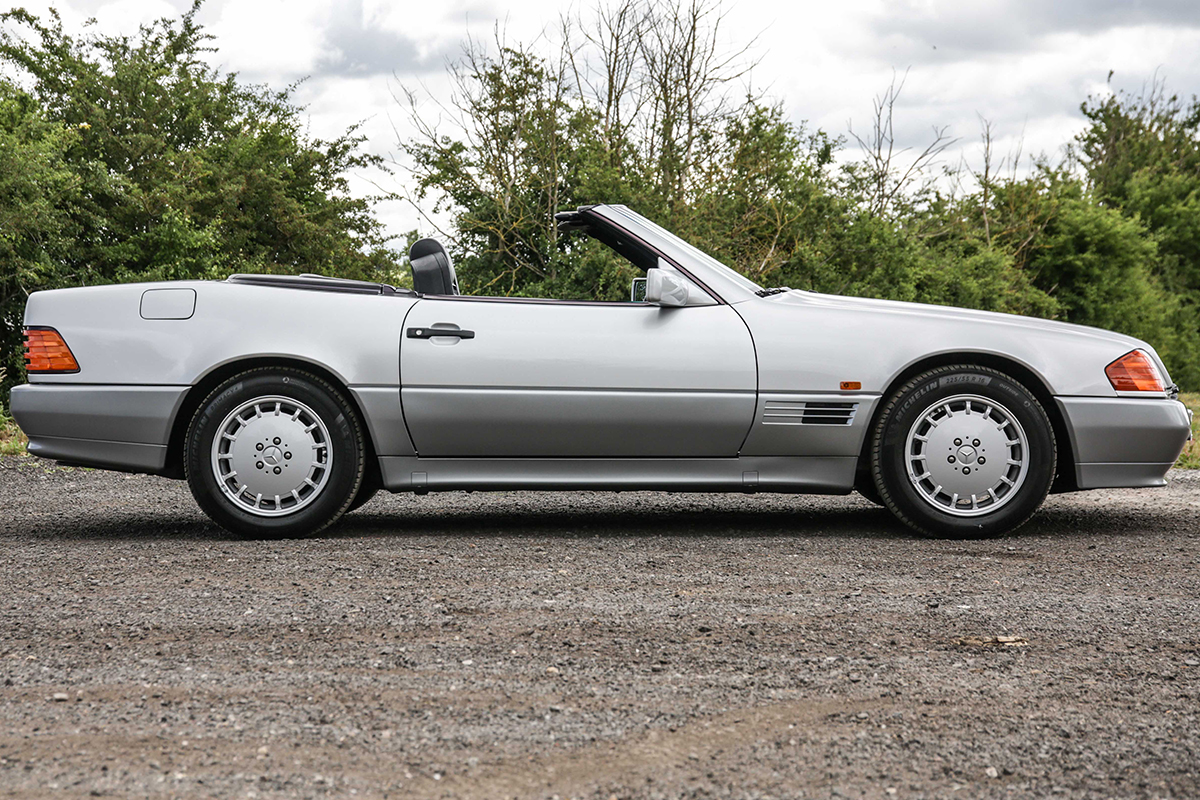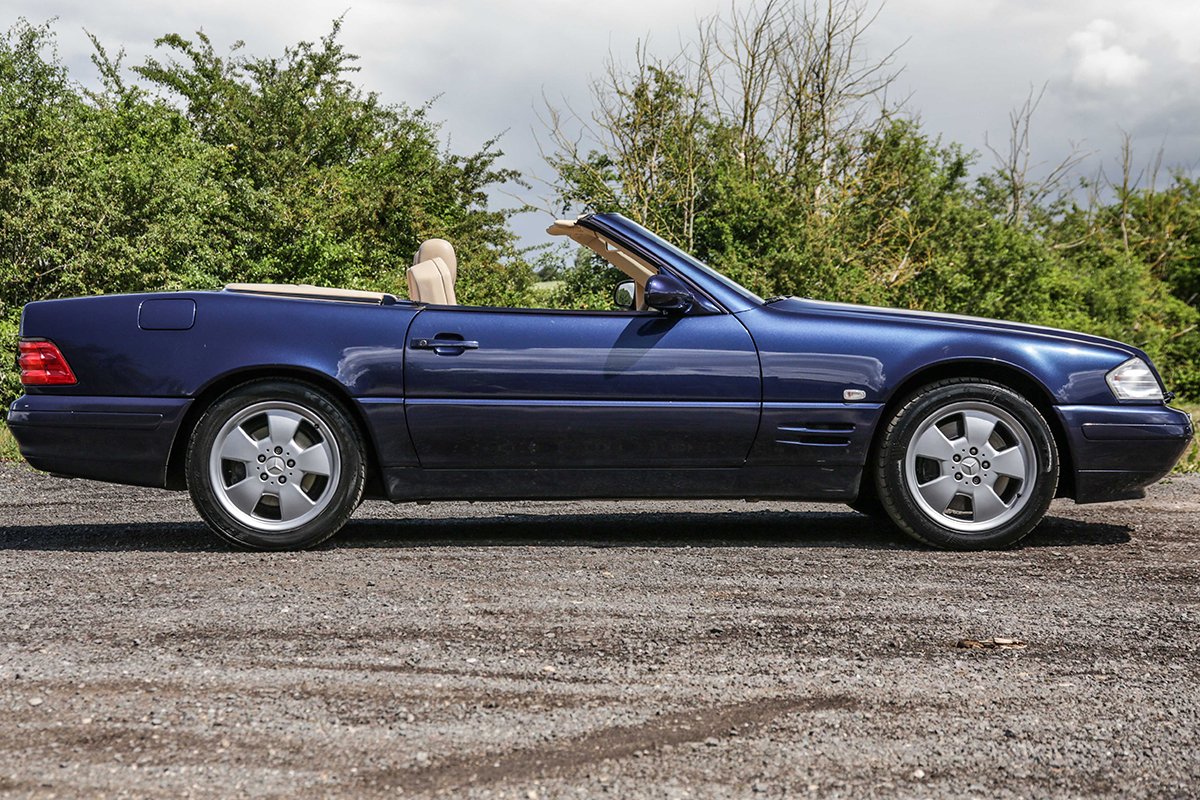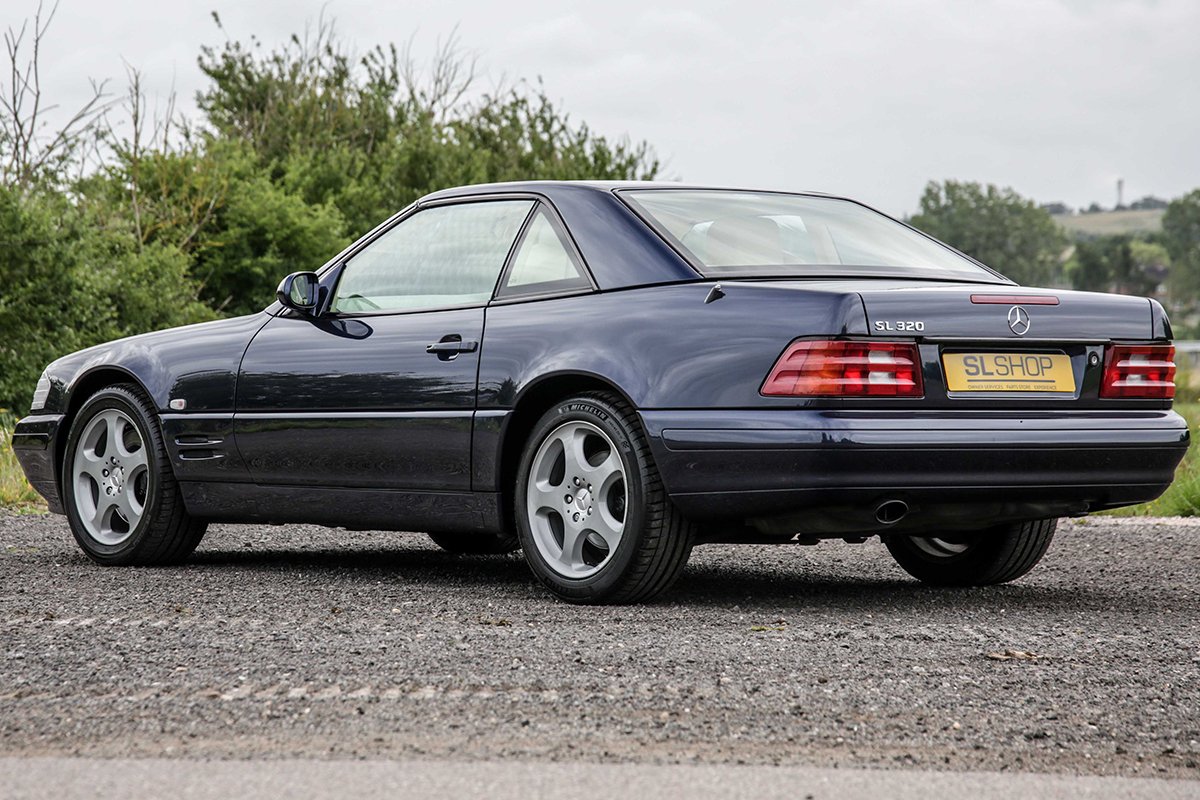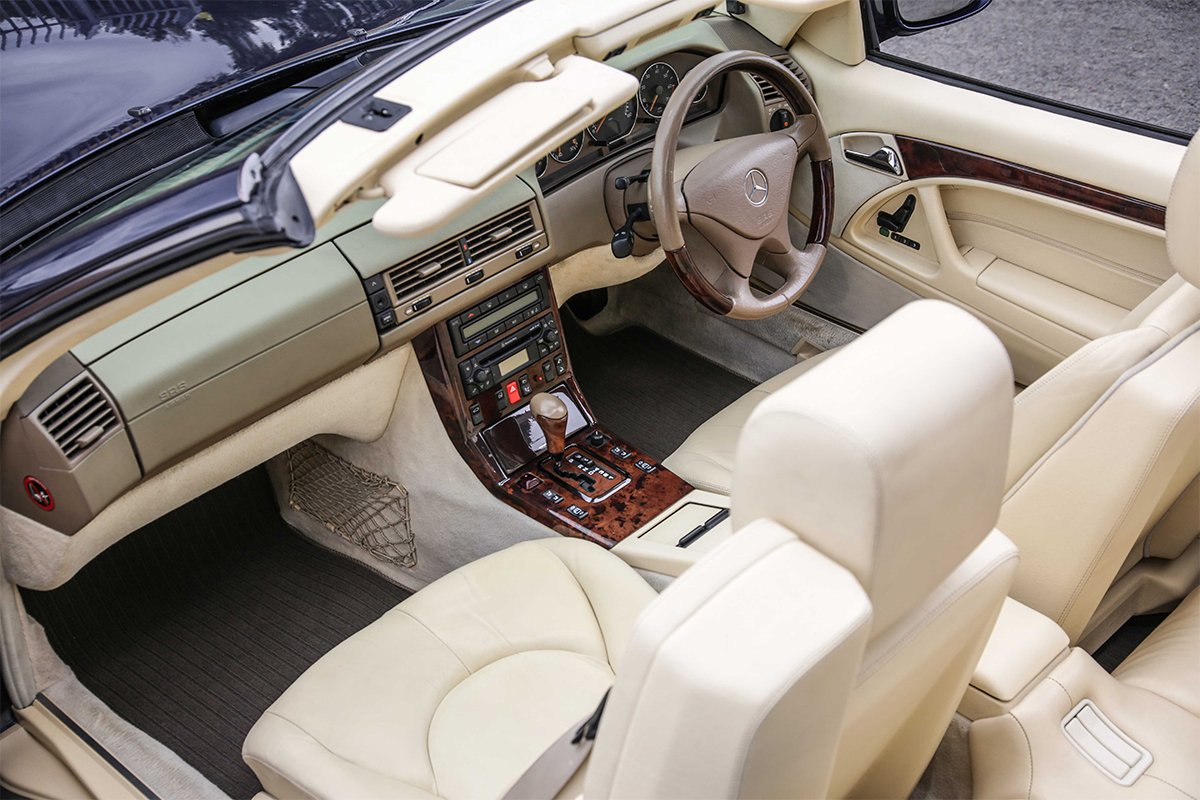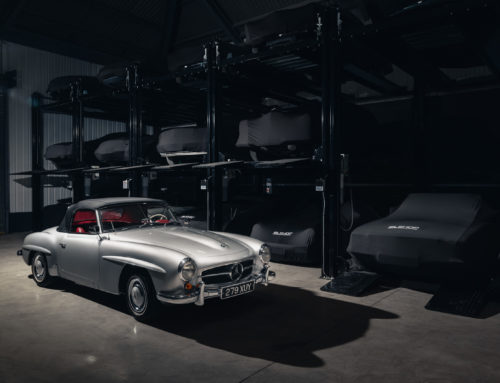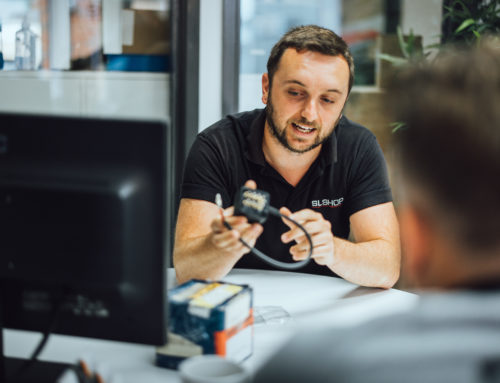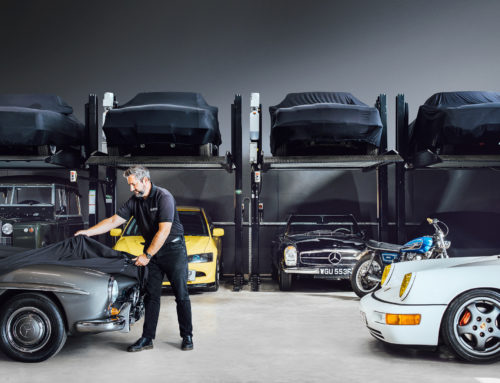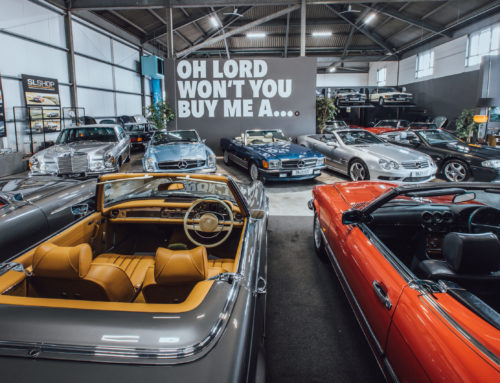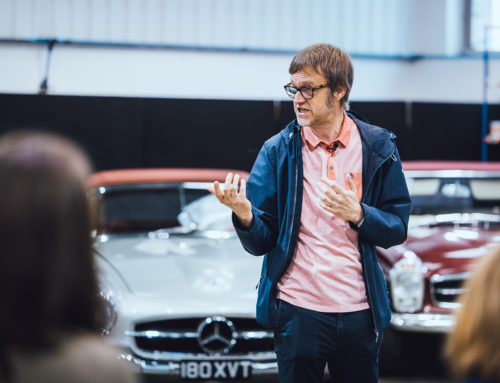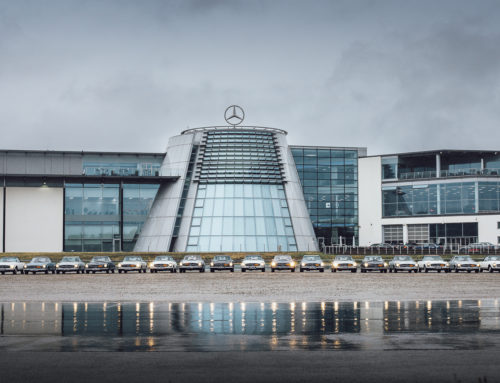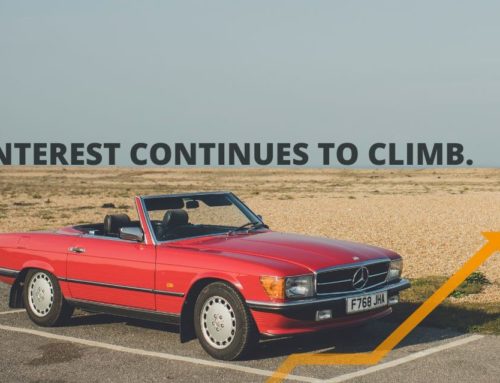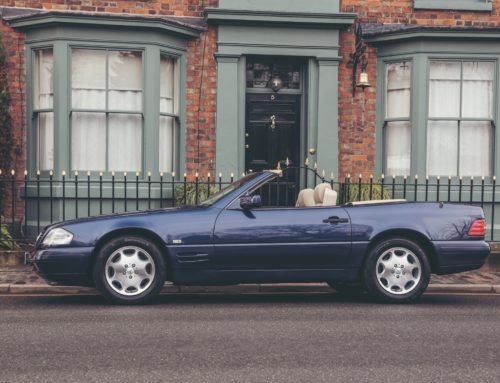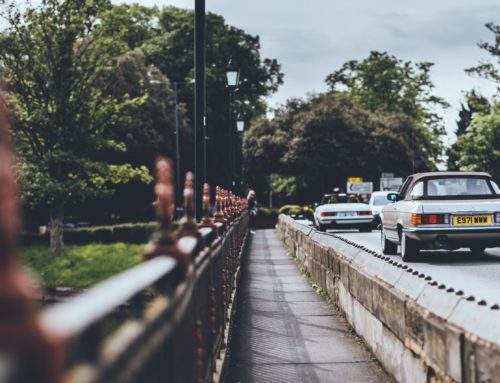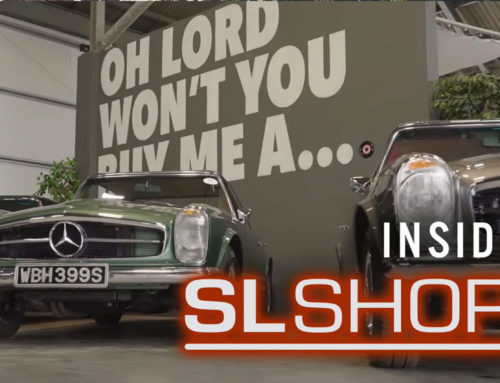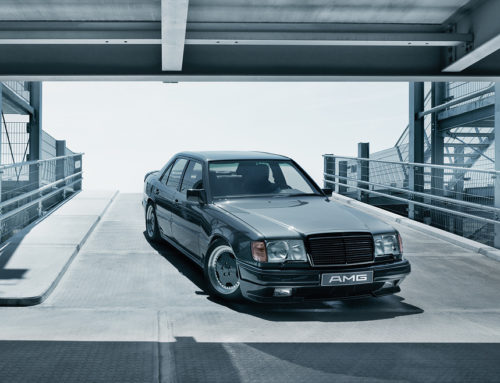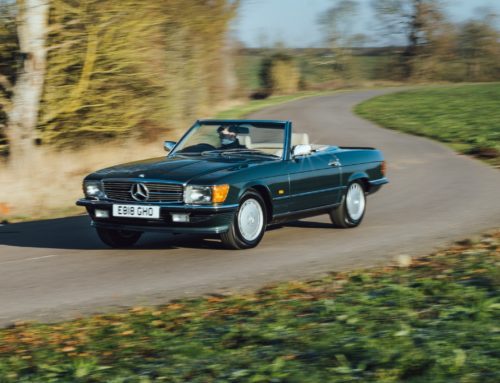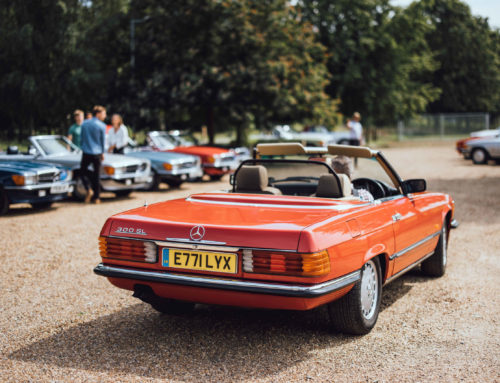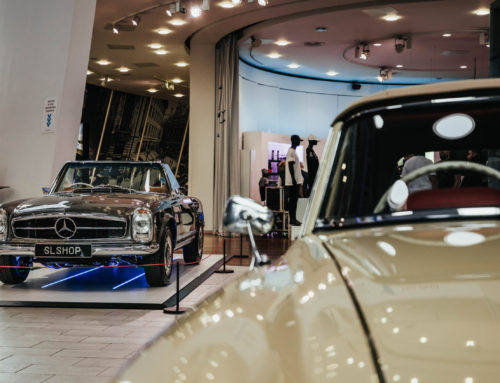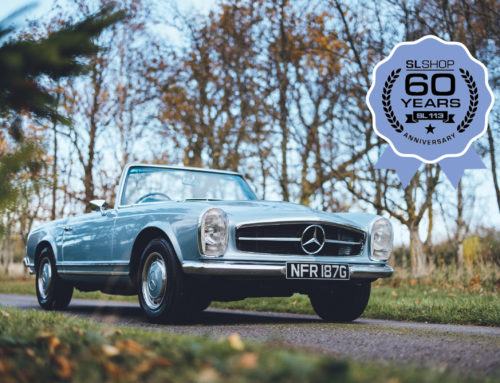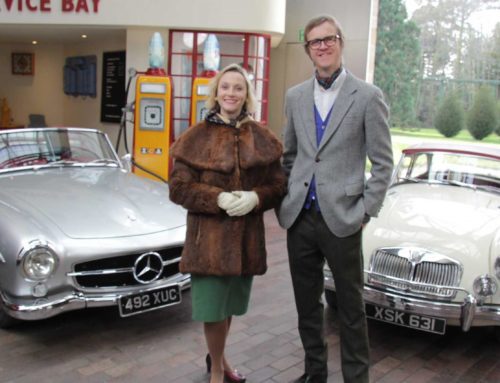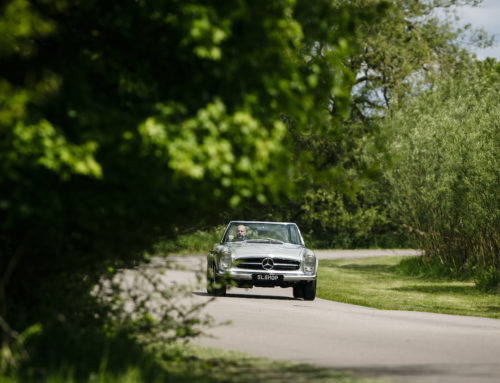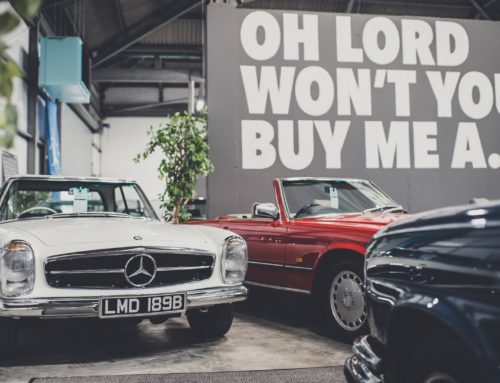When Mercedes-Benz introduced the R129 SL in 1989, it represented a seismic shift in the automotive world. The R107 SL had been in production for almost two decades, and as the 1970s gave way to the 1980s and flowed into the 1990s, the automotive landscape had changed.
By the time Mercedes-Benz updated the R107 SL in 1986, the replacement R129 was already two years into development. The new car would do away with the chrome that defined the R107, a modern and sophisticated grand tourer penned by Bruno Sacco – a bold new direction for Mercedes-Benz design language of the era.
Park an R107 between a Pagoda and an R129 and the differences between the three are stark. The R129 SL was a leap into a technological future, an elegant silhouette that captured everything that the SL was intended to be.
Read more about the R129’s creation here.
For prospective R107 buyers in 1989, the soon-to-be-delivered R129 presented a difficult question… Should one purchase a fine example of the outgoing SL, or an early edition of the next great convertible from Mercedes-Benz? We have seen a number of ‘cancelled order’ cars in our showroom, and know of one particular R107 that remained unregistered and unsold until 1992.
The R129 would go through three generations between 1989 and 2001, split as follows:
1989 to 1996 – 1st Generation
300SL (M103), 300SL-24 (M104), 500SL (M119)
1996 to 1998 – 2nd Generation
SL280 (M104), SL320 (M104), SL500 (M119), SL600 (M120)
1998 to 2001 – 3rd Generation
SL280 V6 (M112), SL320 V6 (M112), 500SL (M119), SL600 (M120)
The exterior styling of the R129 SL remained virtually unchanged between 1989 and 2001, but early cars are easy to distinguish thanks to the orange indicator lenses, three slat gill vents behind the front wheel, seven slats on the radiator and two-tone body colours. They also featured black plastic door handles.
From launch until mid 1990 the standard alloy wheel was the 15 inch design in the same style as the outgoing R107. The smaller wheel was then replaced by a sixteen inch ‘8 hole’ alloy wheel, the wheel design that is synonymous with Mercedes-Benz cars of the 1990s. From 1993 buyers could opt for a 17 inch AMG five spoke design, standard fit to AMG models and in staggered sizes – 8.5 inch at the front and 10 inch at the rear.
An SL500 on 8-hole alloy wheels. Note the sculpted front bumper which raises in the middle, which was changed to a full length front lip on the later cars.
In late 1993 the model designation was changed, with the SL lettering now appearing before the model designation – falling in line with the wider Mercedes-Benz range. The badge remained on the left side of the boot lid, now appearing in a different font and no longer underlined.
At the Frankfurt Motor Show in 1996 Mercedes-Benz announced the launch of the Designo service, allowing customers to order a wide array of different paint and interior finishes. These allowed for almost complete customisation of the car, although Mercedes-Benz dealers would tactfully advise customers on combinations that were ‘not recommended’. Even so, the Designo scheme has given rise to some rather interesting colour schemes over the years.
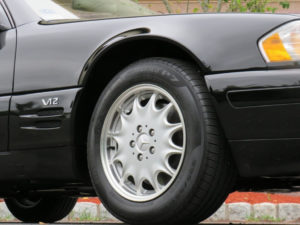
12 hole alloy wheels.
From 1996 Mercedes-Benz introduced generation cars moved to clear indicator lenses, two slat gill vents (that are slightly longer), five slats on the radiator grille and single colour paint. A new 12-spoke style of 16 inch alloy wheel became standard fit, with the 8-hole now an optional alternative. The 17 inch AMG wheel remained an optional extra, whilst cars equipped with the Sport package were fitted with 18 inch wheels.
The final incarnation of the R129 that arrived in 1998 would bring the most significant external aesthetic improvements., Third generation cars from 1998 onwards had reshaped front and rear bumpers, new door mirrors, and body coloured door handles. These later cars also had better lighting thanks to Xenon technology, with smoked lenses for the front indicators and wing-mounted repeaters. The rear lights became more refined and sculpted. From 1999 onwards a new style alloy wheel became standard fit, a five spoke, 17 inch design often known as Albali wheels (shown on the SL320 below). An alternative 17 inch design as added as an option, another five spoke design this time with a flatter face (shown on the SL320 below). Buyers also had the AMG catalogue to choose from, with the Monobloc style well.
- Early 15 inch wheels
- 17 inch ‘Albali’ or ‘five spoke’ wheels
- 17 Inch ‘five hole’ wheels
Throughout the lifecycle of the Mercedes-Benz R129 a number of Special Edition cars were produced. (These should not be confused with Designo cars).
Notable special editions included the La Costa, Mille Miglia, 40th Anniversary Edition, Special Edition, SL Edition, Final Edition, Designo Heritage Edition, Formula One Edition and of course the Silver Arrow.
The R129 would also be one of the first Mercedes-Benz models to benefit from the closer relationship with AMG, spawning the SL55, SL60 and incredibly rare SL70 and SL73 AMG models.
- An early 500SL
- A late SL320
Which Mercedes-Benz R129 should I buy?
The Mercedes-Benz R129 marketplace is vibrant. With just over 200,000 examples built between 1989 and 2001, there is a plethora of choice for prospective R129 SL owners. An R129 can be a joy to own the perfect companion for long distance travel, comfortable on the show ground and a capable grand tourer. Taking into account the minor changes and upgrades throughout production, there are almost 20 different variants in engine alone – so which car should you buy?
The Inline Six Engines
From launch the Mercedes-Benz R129 was offered with two six-cylinder engine choices, the M103 that powered the R107 SL and the new 24 valve M104. These produced 188hp and 228hp respectively, replaced in 1994 by the SL280 and SL320, with power outputs virtually unchanged at 190hp and 228hp.
The straight six engines have a distinct style in an R129, presenting a familiarity to anyone who has spent time with previous generations of SL and a characterful drive. These cars don’t feel underpowered in the real world, but the R129 is noticeably more comfortable when propelled by the larger engines.
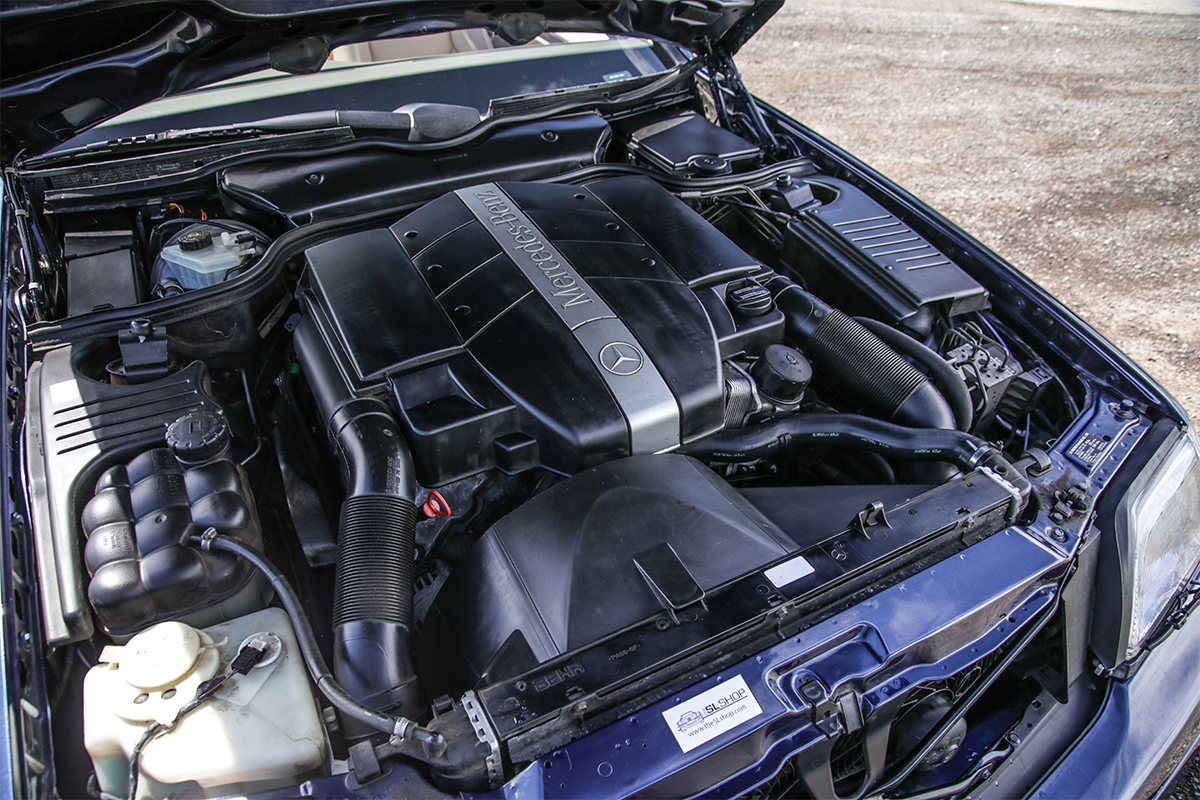
The V6 Engines
The M112 V6 engine was new for 1998, the first time Mercedes-Benz had utilised V6 layout. Like the V8, the six-cylinder had a 90 degree angle, allowing it to share some of the tooling with the M113 V8. The SL280 and SL320 produced 201hp and 222hp respectively.
Arriving at the tail-end of R129 production, the V6 gave the SL a different dynamic, hinting at the shape of things to come. These engines are engaging and capable, with the SL320 being the more accomplished of the two. These give the car a lively feel, distinct from the V8s and thrilling in their own way.

The V8 Engines
The five litre V8 M119 engine fitted to the early R129 offered 322hp, which was throttled slightly from September 1992 thanks to the way the LH Jetronic system was programmed to reduce emissions. From 1995 to 1998 the engine crankshaft and valve timing was modified, pushing output back up to 322hp. Finally in 1998 the M119 was replaced by the M113 engine, just slightly less powerful with 302hp.
A Mercedes-Benz SL is the natural home for a V8 engine, and the 500SL (and SL500) has always been the pin-up car for generations of enthusiasts. With that five-litre 8 cylinder power plant humming away beneath the bonnet, the 500SL is for many people the natural choice when it comes to any SL. Transmissions were 4 speed until 1996, another factor that pushes buyers to the later models.
The Big Twelve
When BMW launched the V12 equipped 750i, Mercedes-Benz responded with a V12 of their own. This would be the most powerful engine in the range (aside from the AMG models), pushing almost 390hp.
Better suited to American style touring, the V12 is the most costly to maintain and run – but the benefits of a large capacity V12 are felt when covering great distances. Under-stressed and refined, these are beautiful to drive. The big question for buyers is whether the extra maintenance and risk would sway you over a V8…

Post 1998 Cars – More kit, more style
The 1998 facelift gave the SL a different character, improving the exterior aesthetics whilst giving the cabin a mild makeover. These later cars are more in demand, with high specification cars in smart colours with low mileage always commanding a premium. A panoramic roof and heated seats can make an R129 SL the ultimate all season tourer, desirable options that also help drive price.
- Early interior…
- Late interior…
When it comes to the R129 SL, our advice remains the same as we have stated in previous buying guides – buy the car you love. Start with the specification that you desire and work backwards from there, take a good look at the available cars and decide which colour would best adorn your driveway.
An early car can be a beautiful thing to hold, clinging to the simple elegance that encompasses everything the SL had become… A later car is a more sporting, more focused drive, with direct styling and more mod cons, but still distinctly an SL.
While the straight-six engines have soul, a V6 offers more punch and the V8 provides road presence, power and noise. The big V12 is smooth as silk but more demanding on the owner.
As a usable classic car, the R129 makes an excellent choice. As Mercedes-Benz values have increased, good quality cars are now being recognised by a wider audience… taking their rightful place in the automotive hall of fame as heir to the R107 dynasty.
Does SLSHOP have a Mercedes R129 SL for sale just for you? Of course. Contact Bruce to discuss your requirements.
Share With Your Fellow Enthusiasts
When Mercedes-Benz introduced the R129 SL in 1989, it represented a seismic shift in the automotive world. The R107 SL had been in production for almost two decades, and as the 1970s gave way to the 1980s and flowed into the 1990s, the automotive landscape had changed.
By the time Mercedes-Benz updated the R107 SL in 1986, the replacement R129 was already two years into development. The new car would do away with the chrome that defined the R107, a modern and sophisticated grand tourer penned by Bruno Sacco – a bold new direction for Mercedes-Benz design language of the era.
Park an R107 between a Pagoda and an R129 and the differences between the three are stark. The R129 SL was a leap into a technological future, an elegant silhouette that captured everything that the SL was intended to be.
Read more about the R129’s creation here.
For prospective R107 buyers in 1989, the soon-to-be-delivered R129 presented a difficult question… Should one purchase a fine example of the outgoing SL, or an early edition of the next great convertible from Mercedes-Benz? We have seen a number of ‘cancelled order’ cars in our showroom, and know of one particular R107 that remained unregistered and unsold until 1992.
The R129 would go through three generations between 1989 and 2001, split as follows:
1989 to 1996 – 1st Generation
300SL (M103), 300SL-24 (M104), 500SL (M119)
1996 to 1998 – 2nd Generation
SL280 (M104), SL320 (M104), SL500 (M119), SL600 (M120)
1998 to 2001 – 3rd Generation
SL280 V6 (M112), SL320 V6 (M112), 500SL (M119), SL600 (M120)
The exterior styling of the R129 SL remained virtually unchanged between 1989 and 2001, but early cars are easy to distinguish thanks to the orange indicator lenses, three slat gill vents behind the front wheel, seven slats on the radiator and two-tone body colours. They also featured black plastic door handles.
From launch until mid 1990 the standard alloy wheel was the 15 inch design in the same style as the outgoing R107. The smaller wheel was then replaced by a sixteen inch ‘8 hole’ alloy wheel, the wheel design that is synonymous with Mercedes-Benz cars of the 1990s. From 1993 buyers could opt for a 17 inch AMG five spoke design, standard fit to AMG models and in staggered sizes – 8.5 inch at the front and 10 inch at the rear.
An SL500 on 8-hole alloy wheels. Note the sculpted front bumper which raises in the middle, which was changed to a full length front lip on the later cars.
In late 1993 the model designation was changed, with the SL lettering now appearing before the model designation – falling in line with the wider Mercedes-Benz range. The badge remained on the left side of the boot lid, now appearing in a different font and no longer underlined.
At the Frankfurt Motor Show in 1996 Mercedes-Benz announced the launch of the Designo service, allowing customers to order a wide array of different paint and interior finishes. These allowed for almost complete customisation of the car, although Mercedes-Benz dealers would tactfully advise customers on combinations that were ‘not recommended’. Even so, the Designo scheme has given rise to some rather interesting colour schemes over the years.

12 hole alloy wheels.
From 1996 Mercedes-Benz introduced generation cars moved to clear indicator lenses, two slat gill vents (that are slightly longer), five slats on the radiator grille and single colour paint. A new 12-spoke style of 16 inch alloy wheel became standard fit, with the 8-hole now an optional alternative. The 17 inch AMG wheel remained an optional extra, whilst cars equipped with the Sport package were fitted with 18 inch wheels.
The final incarnation of the R129 that arrived in 1998 would bring the most significant external aesthetic improvements., Third generation cars from 1998 onwards had reshaped front and rear bumpers, new door mirrors, and body coloured door handles. These later cars also had better lighting thanks to Xenon technology, with smoked lenses for the front indicators and wing-mounted repeaters. The rear lights became more refined and sculpted. From 1999 onwards a new style alloy wheel became standard fit, a five spoke, 17 inch design often known as Albali wheels (shown on the SL320 below). An alternative 17 inch design as added as an option, another five spoke design this time with a flatter face (shown on the SL320 below). Buyers also had the AMG catalogue to choose from, with the Monobloc style well.
- Early 15 inch wheels
- 17 inch ‘Albali’ or ‘five spoke’ wheels
- 17 Inch ‘five hole’ wheels
Throughout the lifecycle of the Mercedes-Benz R129 a number of Special Edition cars were produced. (These should not be confused with Designo cars).
Notable special editions included the La Costa, Mille Miglia, 40th Anniversary Edition, Special Edition, SL Edition, Final Edition, Designo Heritage Edition, Formula One Edition and of course the Silver Arrow.
The R129 would also be one of the first Mercedes-Benz models to benefit from the closer relationship with AMG, spawning the SL55, SL60 and incredibly rare SL70 and SL73 AMG models.
- An early 500SL
- A late SL320
Which Mercedes-Benz R129 should I buy?
The Mercedes-Benz R129 marketplace is vibrant. With just over 200,000 examples built between 1989 and 2001, there is a plethora of choice for prospective R129 SL owners. An R129 can be a joy to own the perfect companion for long distance travel, comfortable on the show ground and a capable grand tourer. Taking into account the minor changes and upgrades throughout production, there are almost 20 different variants in engine alone – so which car should you buy?
The Inline Six Engines
From launch the Mercedes-Benz R129 was offered with two six-cylinder engine choices, the M103 that powered the R107 SL and the new 24 valve M104. These produced 188hp and 228hp respectively, replaced in 1994 by the SL280 and SL320, with power outputs virtually unchanged at 190hp and 228hp.
The straight six engines have a distinct style in an R129, presenting a familiarity to anyone who has spent time with previous generations of SL and a characterful drive. These cars don’t feel underpowered in the real world, but the R129 is noticeably more comfortable when propelled by the larger engines.

The V6 Engines
The M112 V6 engine was new for 1998, the first time Mercedes-Benz had utilised V6 layout. Like the V8, the six-cylinder had a 90 degree angle, allowing it to share some of the tooling with the M113 V8. The SL280 and SL320 produced 201hp and 222hp respectively.
Arriving at the tail-end of R129 production, the V6 gave the SL a different dynamic, hinting at the shape of things to come. These engines are engaging and capable, with the SL320 being the more accomplished of the two. These give the car a lively feel, distinct from the V8s and thrilling in their own way.

The V8 Engines
The five litre V8 M119 engine fitted to the early R129 offered 322hp, which was throttled slightly from September 1992 thanks to the way the LH Jetronic system was programmed to reduce emissions. From 1995 to 1998 the engine crankshaft and valve timing was modified, pushing output back up to 322hp. Finally in 1998 the M119 was replaced by the M113 engine, just slightly less powerful with 302hp.
A Mercedes-Benz SL is the natural home for a V8 engine, and the 500SL (and SL500) has always been the pin-up car for generations of enthusiasts. With that five-litre 8 cylinder power plant humming away beneath the bonnet, the 500SL is for many people the natural choice when it comes to any SL. Transmissions were 4 speed until 1996, another factor that pushes buyers to the later models.
The Big Twelve
When BMW launched the V12 equipped 750i, Mercedes-Benz responded with a V12 of their own. This would be the most powerful engine in the range (aside from the AMG models), pushing almost 390hp.
Better suited to American style touring, the V12 is the most costly to maintain and run – but the benefits of a large capacity V12 are felt when covering great distances. Under-stressed and refined, these are beautiful to drive. The big question for buyers is whether the extra maintenance and risk would sway you over a V8…

Post 1998 Cars – More kit, more style
The 1998 facelift gave the SL a different character, improving the exterior aesthetics whilst giving the cabin a mild makeover. These later cars are more in demand, with high specification cars in smart colours with low mileage always commanding a premium. A panoramic roof and heated seats can make an R129 SL the ultimate all season tourer, desirable options that also help drive price.
- Early interior…
- Late interior…
When it comes to the R129 SL, our advice remains the same as we have stated in previous buying guides – buy the car you love. Start with the specification that you desire and work backwards from there, take a good look at the available cars and decide which colour would best adorn your driveway.
An early car can be a beautiful thing to hold, clinging to the simple elegance that encompasses everything the SL had become… A later car is a more sporting, more focused drive, with direct styling and more mod cons, but still distinctly an SL.
While the straight-six engines have soul, a V6 offers more punch and the V8 provides road presence, power and noise. The big V12 is smooth as silk but more demanding on the owner.
As a usable classic car, the R129 makes an excellent choice. As Mercedes-Benz values have increased, good quality cars are now being recognised by a wider audience… taking their rightful place in the automotive hall of fame as heir to the R107 dynasty.
Does SLSHOP have a Mercedes R129 SL for sale just for you? Of course. Contact Bruce to discuss your requirements.
Share With Your Fellow Enthusiasts
More from Journal
CARE
THE ULTIMATE CERTIFIED SERVICING INVESTMENT PLAN
Your ownership journey matters to us, which is why we have created a simple certified servicing investment plan, tailored to your individual needs and aspirations.
Start investing today and our dedicated CARE team will work with you to increase the value and enjoyment you receive from your vehicle.

STAY IN TUNE WITH SLSHOP MOMENTS
As part of SLSHOP’s community of enthusiasts, you’ll be the first to hear about events and tours, key product offers, exciting stories from owners around the world and of course… our latest additions to the showroom. So, be the first to know and you might just sneak a car on your driveway or take your car’s condition to new heights with our exclusive replacement parts.
Or, visit SLSHOP Journal

